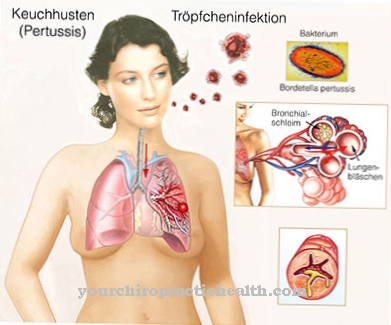The Cryoglobulinemia is a disease from the group of vascular inflammation (vasculitis). In most cases, the inflammation is caused by chronic hepatitis C.
What is cryoglobulinemia?

© Olga - stock.adobe.com
In the Cryoglobulinemia it is a case of vasculitis, i.e. inflammation of the vessels.This inflammation is triggered by the deposition of immune complexes or immunoglobulins in the small blood vessels. These immunoglobulins are known as cryoglobulins. They are insoluble when cold. However, they can go into solution when heated. Mixed cryoglobulins are also called immune complexes.
A distinction can be made between three different types of cryoglobulins:
- Type 1 cryoglobulins are usually monoclonal immunoglobulins G (IgG) or monoclonal immunoglobulins M (IgM).
- The type 2 cryoglobulins are mostly monoclonal immunoglobulin M. This binds to a special piece of IgG. So here are mixed cryoglobulins.
- Type 3 cryoglobulins are polyclonal immunoglobulins M. Together with other polyclonal immunoglobulins, type 3 cryoglobulins form immune complexes.
causes
When it is cold, cryoglobulins lose their ability to dissolve. They are deposited in the small blood vessels and cause inflammation there. As a rule, cryoglobulinemia is a secondary disease of diseases in which there are significantly more immunoglobulins than in a healthy state. In 80 percent of all cases, cryoglubulinaemia is caused by chronic hepatitis C.
Other possible causative diseases are Sjögren's syndrome, borreliosis, rheumatoid arthritis, subacute bacterial endocarditis, syphilis, toxoplasmosis or multiple myeloma. An infection with the Epstein-Barr virus, the causative agent of Pfeiffer's glandular fever, can also result in cryoglobulinemia.
Symptoms, ailments & signs
The inflammation damages the vessel walls. This damage to the vascular wall occurs in particular on the hands, feet, nose, ears, chin, penis and vulva. This is where skin bleeding appears, which is known as palpable purpura. In addition, there is acrocyanosis or necrosis of the acra. Acrocyanosis is a blue coloration of the acra.
Acra are the parts of the body that are furthest away from the torso. Raynaud's syndrome is a typical manifestation of cryoglobulinemia. The disease is also known as Raynaud's disease and is characterized by attacks of pale fingers. This pale is due to a convulsive narrowing of the inflamed blood vessels. In addition, joint and muscle pain can occur. The patients also complain of neurological symptoms such as tingling or pins and needles.
Liver enlargement is found in more than half of the patients. The spleen can also be enlarged. Enlargement of the spleen and liver are typical of cryoglobulinemia caused by Waldenström's disease or plasmacytoma. Lymph node diseases can also occur. In some cases, glomerulonephritis will develop.
Here the kidney corpuscles are inflamed. This leads to blood (hematuria) and proteins (proteinuria) in the urine. In severe forms, multiple organ infarctions can occur. Kidney infarction, stroke, heart attack or mesenteric infarction are acutely life-threatening.
Diagnosis & course of disease
The anamnesis provides the first indications of cryoglobulinemia. There may be evidence of chronic hepatitis C. At a temperature of 37 degrees Celsius the sedimentation rate is greatly increased, but at a temperature of four degrees Celsius it is normal. The cryoglobulins circulating in the blood can be detected using the method of electrophoresis.
During electrophoresis, the serum proteins are separated and presented in their individual fractions. In cryoglobulinemia, the γ-globulins are found in increased numbers in the blood. The diagnosis can be confirmed with a vascular biopsy. Here a piece of vessel is removed. The inflammation can be detected on the basis of this piece of vessel.
Complications
Cryoglobulinemia usually damages the vessel walls. Mainly skin bleeding occurs, which can be associated with pain. Furthermore, the skin is also colored blue by the disease and swelling can occur in the affected areas. It is not uncommon for movement restrictions on the body to occur, which can make the patient's everyday life significantly more difficult.
Pain in the muscles and joints is also not uncommon in cryoglobulinemia and can significantly reduce the patient's quality of life. The disease also enlarges the liver. In the worst case, diseases of the liver can lead to the patient's death. It is not uncommon for the heart to be affected by the disease, so that a heart attack can continue to occur.
Kidney infarction cannot be ruled out in cryoglobulinemia either. The life expectancy of the patient is considerably reduced and restricted by the cryoglobulinemia. Treatment of this disease takes place with the help of drugs. There are no complications. The symptoms can be treated with the help of ibuprofen. As a rule, it cannot be universally predicted whether there will be a reduction in life expectancy.
When should you go to the doctor?
Discoloration of the skin on various parts of the body is cause for concern. If blue discolouration occurs repeatedly or if there is an increase in discoloration, a doctor should be consulted to clarify the symptoms. The hands, feet, ears, nose and chin are particularly at risk. The cause of the skin abnormalities should be examined and treated by a doctor. In some cases the blue discoloration occurs in the area of the genital organs. Therefore, a doctor's visit is also required if the penis or vulva show changes.
If the fingers suddenly turn pale, which cannot be explained, a doctor should be informed of the observations. A doctor is needed if there are sensory disorders on the skin, a tingling sensation or numbness. Consult a doctor if you experience joint pain or muscular disorders. This is especially true if no physical overexertion or intense sporting activities have taken place. A doctor should be consulted if there is a feeling of tightness in the upper body, circulatory problems or irregular heart rhythm.
If the symptoms persist for a long time, a life-threatening condition can develop. Therefore, a doctor should be seen at the first signs. In the event of a functional failure or loss of consciousness, an emergency doctor must be called. In addition, it is necessary to take first aid measures to ensure the survival of the person concerned.
Therapy & Treatment
The basis of therapy is the treatment of the underlying disease. In the case of chronic hepatitis C, this is no easy task. Those affected receive a combination of interferon-α and the antiviral agent ribavirin for a period of at least six months. In the case of a high viral load and infection with various subtypes, however, the therapy only works poorly. Overall, the success rate is 50 percent.
In addition to treating the underlying disease, high doses of corticosteroids are used. Chemotherapy drugs and interferons are also used. The standard dosage consists of cyclophosphamide, prednisolone and ibuprofen. Ibuprofen is only used for symptomatic treatment.
You can find your medication here
➔ Drugs for wound treatment and injuriesOutlook & forecast
The prognosis of cryoglobulinemia depends on the underlying disease. The treatment option for the offending disease is crucial for the further course of the disease and the prospect of recovery. In addition, it is of particular importance whether the disease at hand is chronic in character. For example, if the person has hepatitis C, the treatment plan and the chances of recovery are particularly difficult and lengthy. The probability of achieving freedom from symptoms is only about half of the diagnosed cases. In addition, side effects and risks can occur within an initiated therapy.
Without medical and medical treatment, the prognosis for those affected worsens immensely. Secondary diseases are possible and there is also the risk of serious complications. Kidney infarction is diagnosed in some patients. This is potentially life-threatening for the person concerned and can lead to lifelong impairments if intensive medical care is successful. In addition, the average life expectancy in these patients decreased overall.
If the attending physician succeeds in curing the underlying disease, the symptoms of cryoglobulinemia gradually disappear on their own. In spite of the achieved healing, a relapse can occur in the course of life. The organism does not develop any immunity from the germs that cause the disease. Therefore, special precautionary measures should be taken in order to maintain long-term freedom from symptoms.
prevention
In principle, cryoglobulinemia can only be prevented by preventing the underlying disease. Hepatitis C is a major risk factor for developing cryoglobulinemia. The liver inflammation caused by the hepatitis C virus shows a very high rate of chronicity and can also cause liver damage. The disease is transmitted through the blood. A vaccination is not yet possible. There is an increased risk of infection with intravenous drug use.
Hepatitis C can also be transmitted through contaminated instruments in tattoo or piercing studios. Sexual transmission is rather rare. To prevent hepatitis C and thus also to prevent cryoglobulinemia, tattoo and piercing studios should be carefully examined before the actual piercing appointment. Hygienic work should be a matter of course.
Drug addicts should not share syringes with other users, but should always use sterile disposable syringes. Despite the low risk of transmission, only protected intercourse should be exercised with regard to other sexually transmitted diseases. In the case of known diseases that are associated with an increased production of immunoglobulins, those affected should watch out for symptoms such as cold and pale hands or bleeding.
If vascular inflammation is suspected, a doctor should be consulted immediately. Early treatment improves the prognosis and prevents permanent damage such as neuropathy and muscle pain.
Aftercare
In most cases, follow-up care options for cryoglobulinemia are severely limited, and in some cases they are not available to the person concerned. The further course of the disease is very much dependent on the condition of the person affected and also on the time of diagnosis, so that no general predictions can be made about it.
However, an early diagnosis of the disease usually always has a positive effect on the further course of the cryoglobulinemia, so that the person affected should ideally see a doctor at the first signs and symptoms. As a rule, it cannot heal independently. Those affected are dependent on taking various drugs.
These usually have to be taken over a period of six months, always ensuring that they are taken regularly and that the dosage is correct. In addition, regular checks and examinations should be carried out by a doctor so that the condition of the person concerned is permanently monitored. In most cases, cryoglobulinemia can be overcome relatively well, so that no further follow-up measures are necessary.
You can do that yourself
In the case of cryoglobulinemia, self-help measures are usually limited to supporting medical treatment of the symptoms and making everyday life with the disease easier. First of all, a change in lifestyle is advisable. Since cryoglobulinemia is mostly due to bacterial diseases, the immune system must be strengthened. This is achieved by exercising a lot in the fresh air and eating healthily. In addition, attention should be paid to a restful night's sleep and the avoidance of stress.
If the symptoms are based on a serious illness that was not only caused by a bacterial pathogen, symptomatic accompanying treatment is possible. For example, pain can be relieved by a number of natural medicine remedies. The preparations Belladonna D12 from homeopathy as well as arnica and devil's claw from naturopathy have proven themselves. Conservative measures such as warm pads also help with local pain.
Depending on the underlying condition of the cryoglobulinemia, additional measures may be taken. However, this should be discussed with a doctor beforehand in order to avoid discomfort and serious complications.

.jpg)

.jpg)









.jpg)

.jpg)
.jpg)











.jpg)